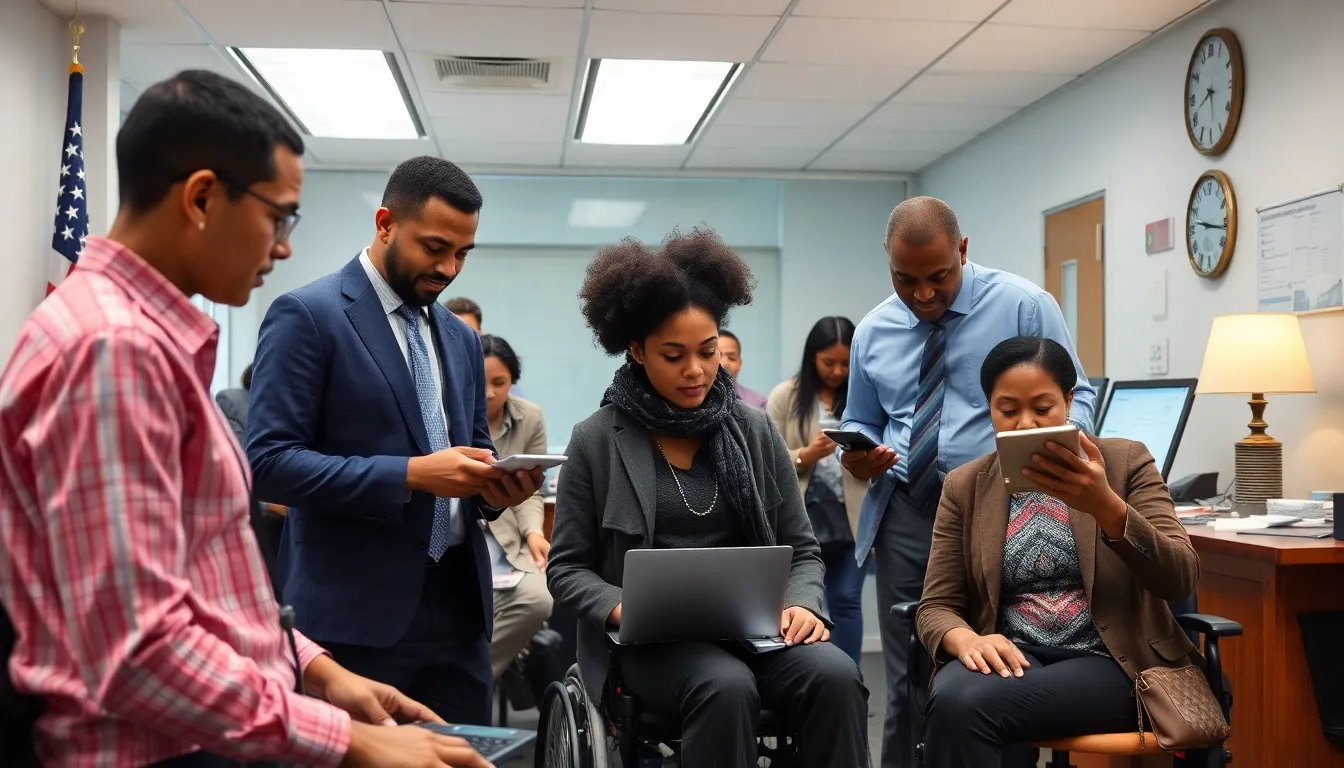Table of Contents
ToggleIn a world where technology seems to evolve faster than a toddler on a sugar rush, GovTech accessibility is the unsung hero we didn’t know we needed. Imagine a future where everyone, regardless of their abilities, can easily navigate government services—no more deciphering bureaucratic hieroglyphs or wrestling with outdated websites. It’s not just a dream; it’s a necessity.
As governments embrace digital transformation, the focus on accessibility becomes crucial. After all, if a website can sell you cat socks in three clicks, surely it can help you file your taxes without a PhD in computer science. By prioritizing accessibility, governments can ensure that every citizen feels empowered, informed, and ready to engage with their civic duties. Let’s dive into how GovTech is breaking down barriers and making democracy a little less daunting for everyone.
Overview of GovTech Accessibility
GovTech accessibility focuses on ensuring that all citizens can effectively use government services. This approach addresses the barriers that individuals with diverse abilities face when interacting with digital platforms. Accessible websites allow citizens to complete tasks, like filing taxes or applying for permits, with ease.
Improving accessibility can significantly impact civic engagement. Citizens who can navigate online services intuitively are more likely to participate in democratic processes. Making government platforms user-friendly encourages interaction, fostering a more inclusive society.
Numerous studies show that accessible technology not only enhances user experience but also increases participation rates. Research indicates that approximately 15% of the global population experiences some level of disability. By prioritizing accessible solutions, governments can reach a broader audience and promote equal access to services.
Innovative strategies exist to enhance GovTech accessibility. Adopting standards like the Web Content Accessibility Guidelines (WCAG) ensures compliance and creates a more inclusive environment. Also, implementing user feedback mechanisms allows for continuous improvement of digital services.
Considering the future, governments must invest in accessible technologies. Partnerships with organizations specializing in accessibility can enhance knowledge and resource sharing. Such collaborations yield innovative solutions, making government services accessible for everyone.
Importance of GovTech Accessibility

GovTech accessibility plays a crucial role in enhancing the user experience for all citizens. By ensuring digital platforms are accessible, governments promote inclusivity and engagement.
Benefits for Citizens
Accessible digital services empower all citizens, making it easier to interact with government systems. User-friendly platforms allow individuals with diverse abilities to navigate tasks like filing taxes or obtaining permits efficiently. Technologies adhering to the Web Content Accessibility Guidelines (WCAG) dramatically reduce barriers. Research shows that around 15% of the global population faces some level of disability, highlighting the need for accessible solutions. Citizens benefit from solutions that foster seamless participation in democratic processes. Ultimately, an inclusive approach can lead to higher civic engagement rates.
Enhancements for Government Services
Implementing accessibility improves overall government service delivery. Agencies adopting inclusive technologies experience a boost in public trust and satisfaction. User feedback mechanisms enable ongoing enhancements, ensuring digital platforms evolve with citizens’ needs. Investment in accessible solutions leads to innovative practices that streamline various processes. Prioritizing accessibility can create efficiencies, reducing operational costs over time. Collaboration with accessibility-focused organizations fosters knowledge sharing and best practices. Ultimately, enhancing accessibility strengthens democracy by allowing more citizens to engage with government services.
Challenges in Achieving GovTech Accessibility
Achieving GovTech accessibility presents various challenges that hinder widespread implementation. These challenges include technological barriers and policy and regulatory issues.
Technological Barriers
Technological limitations often pose significant obstacles to GovTech accessibility. Many government platforms lack compatibility with assistive technologies, making navigation difficult for users with disabilities. Websites frequently overlook best practices in design and usability, leading to frustration for users. Furthermore, legacy systems may hinder the integration of accessibility features. Agencies sometimes lack resources or expertise to implement necessary changes. Innovative solutions exist but may not be prioritized due to budget constraints or technical resistance.
Policy and Regulatory Issues
Policy and regulatory frameworks impact GovTech accessibility as well. Many governments face challenges in establishing comprehensive policies that mandate accessibility across all digital services. Some regulations lack enforcement mechanisms, reducing accountability for accessible design. Inconsistent standards can result in varying levels of accessibility across services. Collaboration among stakeholders often remains insufficient for creating effective solutions. Unclear guidelines on accessibility requirements lead to confusion, delaying progress toward inclusive government services.
Best Practices for Enhancing GovTech Accessibility
Enhancing GovTech accessibility requires actionable strategies to create truly inclusive government services. Prioritizing these practices ensures that all citizens can effectively engage with digital platforms.
User-Centered Design
User-centered design focuses on the needs and preferences of all users. By involving individuals with disabilities in the design process, agencies gain valuable insights. This approach leads to intuitive interfaces that simplify navigation for everyone. Testing prototypes with diverse users identifies potential barriers early. Additionally, continuous iteration based on user feedback helps refine services. Implementing accessible features, such as text-to-speech options and clear navigation paths, fosters inclusivity for various abilities. Adoption of this design philosophy enhances user satisfaction and encourages wider participation in civic processes.
Collaboration with Stakeholders
Collaboration with stakeholders enhances the effectiveness of accessibility initiatives. Working together, government agencies can unite with disability advocacy groups to share knowledge and resources. Establishing partnerships encourages cross-sector dialogue on best practices. Regular workshops and information sessions educate stakeholders about emerging accessibility technologies. Transparent discussions facilitate alignment on accessibility goals across various platforms. Gathering perspectives from different communities ensures comprehensive solutions. Engaging diverse stakeholders also fosters trust in government initiatives. Ultimately, this collaborative approach leads to a more inclusive digital landscape for all citizens.
Case Studies in Successful GovTech Accessibility
Case studies illustrate effective GovTech accessibility efforts that enhance citizen engagement. Successful initiatives demonstrate the positive impact of inclusive design principles worldwide.
International Examples
Canada recently launched an accessible digital platform designed for tax filing. This initiative incorporated user-centered design principles, ensuring all citizens, including those with disabilities, can navigate the site easily. Similarly, Australia’s Government Digital Service emphasizes WCAG adherence, enabling users with diverse needs to access vital services efficiently. These international examples showcase how prioritizing accessibility fosters an inclusive environment, allowing citizens to interact seamlessly with government services.
Local Success Stories
In the United States, the state of Oregon developed an accessible voter registration system that significantly increased participation among individuals with disabilities. This system includes streamlined processes and assistive technologies, ensuring ease of use. Furthermore, New York City’s 311 service enhanced its digital platforms by implementing text-to-speech options, allowing users to access information regardless of their abilities. Local success stories demonstrate a commitment to accessibility, proving that inclusive designs can increase engagement and improve civic participation effectively.
GovTech accessibility is a vital component in fostering an inclusive democracy. By prioritizing user-friendly digital services, governments can break down barriers that hinder participation from individuals with diverse abilities. The commitment to accessible solutions not only enhances civic engagement but also builds public trust in government systems.
As agencies continue to implement innovative strategies and best practices, the potential for increased participation in democratic processes grows. Collaboration with stakeholders and continuous user feedback will ensure that these digital platforms meet the needs of all citizens. Ultimately, embracing accessibility is not just a regulatory requirement; it’s a crucial step toward a more engaged and empowered society.





